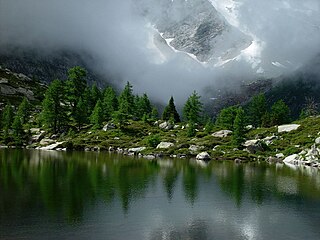
Prasophyllum alpestre, commonly known as the mauve leek orchid, is a species of orchid endemic to eastern Australia. It has a single tubular, green leaf and up to twenty five scented, white, purplish and green flowers. It grows in subalpine parts of New South Wales, Victoria and Tasmania.

Prasophyllum petilum, commonly known as the Tarengo leek orchid, is a species of orchid endemic to eastern Australia. It has a single tubular, green leaf and up to eighteen pinkish mauve to greenish flowers, well-spaced along a slender flowering stem. It is a small orchid, difficult to locate, generally growing in taller grasses.
Prasophyllum campestre, commonly known as the sandplain leek orchid, or inland leek orchid, is a species of orchid endemic to eastern Australia. It has a single tubular, yellowish-green leaf and up to twenty greenish, strongly scented flowers with red, purplish, brown or white marks. It grows in the drier parts of Queensland, New South Wales and Victoria.

Prasophyllum odoratum, commonly known as the fragrant leek orchid, Rogers scented leek orchid or sweet leek orchid is a species of orchid endemic to south-eastern Australia. It has a single tubular leaf and up to fifty fragrant green and white flowers with reddish marks.

Prasophyllum wilkinsoniorum is a species of orchid endemic to New South Wales. It has a single tubular, bright green leaf and up to forty five scented, dark greenish-brown to brownish-red flowers with a green to pinkish labellum. It grows in grassy places in a restricted area on the Southern Tablelands.

Prasophyllum canaliculatum, commonly known as the channelled leek orchid or summer leek orchid, is a species of orchid endemic to a small area of southern New South Wales. It has a single tubular, bright green leaf and up to twenty five scented, greenish-red or brownish flowers on a flowering stem. It grows in woodland at altitudes around 1,000 m (3,000 ft) where only about two hundred plants survive.

Prasophyllum caudiculum, commonly known as the Guyra leek orchid, is a species of orchid endemic to a small area of northern New South Wales. It has a single tubular, bright green leaf and up to thirty five greenish to reddish-brown flowers crowded along an erect flowering stem. It grows in grassy places near Guyra.
Prasophyllum crebriflorum, commonly known as the crowded leek orchid, is a species of orchid endemic to Tasmania. It has a single tubular, dark green leaf with a purplish base and up to twenty five reddish-brown flowers. It is only known from four relatively small populations growing at high altitudes.

Prasophyllum dossenum is a species of orchid endemic to a small area of northern New South Wales. It has a single tubular, dark green leaf and up to thirty scented pinkish-white and greenish-brown flowers crowded along an erect flowering stem. It is a rare orchid which grows in grassy places on the Northern Tablelands of New South Wales.
Prasophyllum incurvum is a species of orchid endemic to Tasmania. It has a single tubular, bright green leaf and up to forty brownish-green, white and purplish flowers. It is similar to P. alpestre but has larger flowers and petals which curve forwards.
Prasophyllum milfordense is a species of orchid endemic to Tasmania. It has a single tubular, dark green leaf and up to thirty greenish-brown, white and purplish flowers. It is a very rare orchid, only found in a single location with a population of around 240 plants.

Prasophyllum solstitium is a species of orchid endemic to the Northern Tablelands of New South Wales. It has a single tubular, bright green leaf and up to thirty five greenish-pink to purplish-red flowers crowded on the flowering stem. It grows in grassland on heavy basalt soil.
Prasophyllum retroflexum, commonly known as the congested leek orchid or Kiandra leek orchid, is a species of orchid endemic to a small area near the border between New South Wales and Victoria, growing in subalpine herbfields. It has a single tubular leaf and up to forty densely-crowded, pale green flowers with pinkish markings.
Prasophyllum beatrix, commonly known as the Marung leek orchid, is a species of orchid endemic to eastern Australia. It has a single tubular leaf and up to thirty five scented flowers with yellowish-green or purplish markings and is mainly confined to New South Wales.
Prasophyllum catenemum is a species of orchid endemic to South Australia. It has a single tubular leaf and up to twenty white and green to purplish flowers. It is only known from a small area of the coast of the state where it grows in shrubland which is often engulfed by uynstable sand dunes.
Prasophyllum collinum is a species of orchid endemic to South Australia. It has a single tubular leaf and up to thirty lemon-scented, greenish brown and white flowers. It is only known from the Eyre Peninsula where it grows in sparse woodland.
Prasophyllum helophilum is a species of orchid endemic to New South Wales. It has a single tubular green leaf and up to twenty five purplish white and brown flowers. It grows in wet, swampy places on the central tablelands.
Prasophyllum praecox, commonly known as the early leek orchid, is a species of orchid endemic to eastern Australia. It has a single tubular leaf and up to ten green to greenish brown and white flowers and is found in the southern parts of the Yorke Peninsula in South Australia.
Prasophyllum holzingeri is a species of orchid endemic to New South Wales. It has a single tubular, shiny dark green leaf and up to fifteen unscented, greenish to brownish pink and white flowers. It is only known from a few populations in the Barrington Tops area.
Prasophyllum pilligaense is a species of orchid endemic to New South Wales. It has a single tubular, shiny dark green leaf and up to thirty scented greenish brown to brownish and white flowers. It is only known from a few populations in the Coonabarabran district.

















